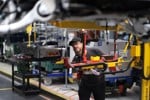As electric vehicles slowly become mainstream in the fleet sector, fleet decision-makers are working with new challenges when EVs requires servicing.
At the Fleet200 Strategy Network meeting in December, members revealed the challenges they were facing on a daily basis.
“It’s a massive issue for us right now. Starting off with the prioritisation of vehicle types in the garage. I went to see a major manufacturer which gave me a tour of the workshop facility. The EV service bay took up the space of three ICE bays. If you’re an independent, can you afford to reduce the number of vehicles you can service simultaneously with the results loss in revenue?”
“Some manufacturers are starting to step on the labour rates. Let’s say they’re £80 an hour for ICE vehicles, it’s £105 for an EV. It’s akin to a seat in business class. The space it takes up is bigger, therefore you pay a premium.”
“The cost and availability of parts is a major problem. The difficulty in getting the most basic parts can mean an EV is off the road for three months.”
“EV servicing is pretty straightforward. Mobile serving at a driver’s workplace or on their drive, is far more efficient for EVs, as long as you have the right infrastructure around you, than a workshop. Plus, basic diagnostics, such as on brakes and tyres, can be done remotely.”
“We had a fleet decarbonisation strategy and I was ready to complete it by 2026. Having looked at the EV repair capability and parts availability, we pushed it to 2030.”
As electric vehicles slowly become mainstream in the fleet sector, fleet decision-makers are working with new challenges when EVs requires servicing.
At the Fleet200 Strategy Network meeting in December, members revealed the challenges they were facing on a daily basis.
The challenges in EV servicing
“It’s a massive issue for us right now. Starting off with the prioritisation of vehicle types in the garage. I went to see a major manufacturer which gave me a tour of the workshop facility. The EV service bay took up the space of three ICE bays. If you’re an independent, can you afford to reduce the number of vehicles you can service simultaneously with the results loss in revenue?”
“Some manufacturers are starting to step on the labour rates. Let’s say they’re £80 an hour for ICE vehicles, it’s £105 for an EV. It’s akin to a seat in business class. The space it takes up is bigger, therefore you pay a premium.”
“The cost and availability of parts is a major problem. The difficulty in getting the most basic parts can mean an EV is off the road for three months.”
“EV servicing is pretty straightforward. Mobile serving at a driver’s workplace or on their drive, is far more efficient for EVs, as long as you have the right infrastructure around you, than a workshop. Plus, basic diagnostics, such as on brakes and tyres, can be done remotely.”
“We had a fleet decarbonisation strategy and I was ready to complete it by 2026. Having looked at the EV repair capability and parts availability, we pushed it to 2030.”
“If you start ramping up your decarbonisation drive now for 2030, you’re going to have a lot of assets which will be worth nothing due to the fact solid state vehicle batteries, being introduced in 2027/28. Take on vehicles now and you’ll be wanting to put them into the used market when everyone wants solid state batteries and double the range we have now. It’s a dilemma whether to make the switch now ahead of 2035 or wait until 2027/28.”
“A look at some service, maintenance and repairs budgets showed that historically, tyres made up about 18 – 20% of overall budgets. With EV, it’s 33 – 35%. EV tyres are generally more expensive because they’re on bigger rims. And it’s only going to get worse as the price of rubber increases. So, do you unbundle tyres from the leasing agreement and operate on a pay-as-you-go basis?”
EVs and tyre wear
I get asked all the time if tyres wear out quicker on EVs than ICE vehicles, and the answer is no.
"The wear is entirely down to driver behaviour. I see one EV with 30,000 miles on the clock still on OE tyres, while another, practically the same vehicle and age, with 15,000 miles and they’re burned to the ground. It’s the acceleration on offer in an EV and the heavy right foot being applied in bringing it to a stop.”
Repair times for EVs
“We don’t see longer repair times, but more incidents of total loss of a vehicle. Particularly if there is battery damage. It’s easier to right off a vehicle and supply you a replacement.”
“Be minded to split your KPIs for ICE and EVs when it comes to servicing times.
"You might be accustomed to your ICE fleet being off the road for three days, but for EVs it might be three months. This is particularly a risk for warranty work. There’s no obligation to contact the leasing or fleet management company because it’s covered.”
“I’ve heard of companies using telematics to geofence the dealerships they were using and would track vehicle activity on the site.
"They would know that a vehicle’s engine hadn’t been started, that no work had been done on a vehicle in several days and raise this with the site. Or using forward facing cameras in the vehicles to check on work progress.”
Login to continue reading.
This article is premium content. To view, please register for free or sign in to read it.




















Login to comment
Comments
No comments have been made yet.